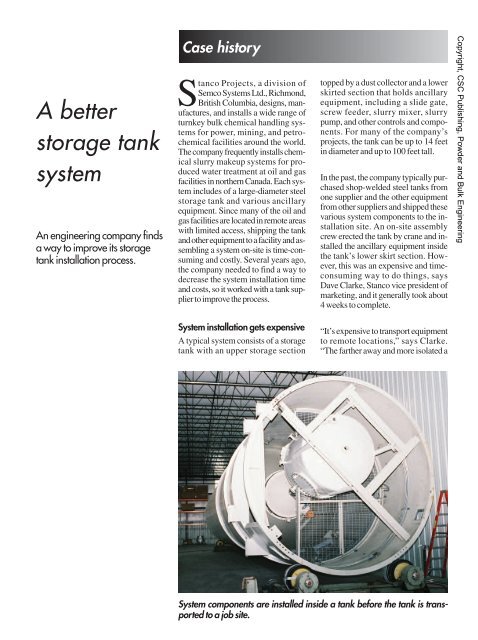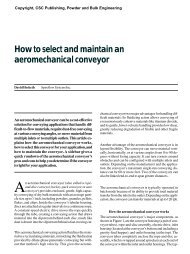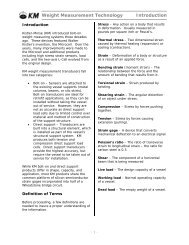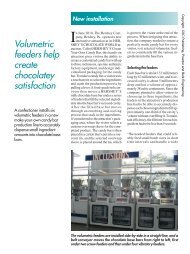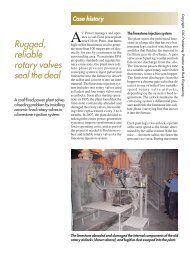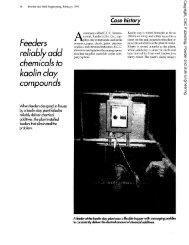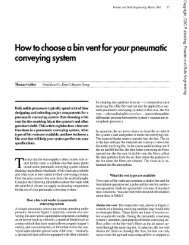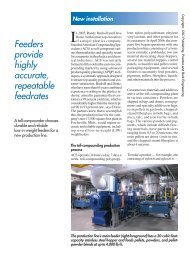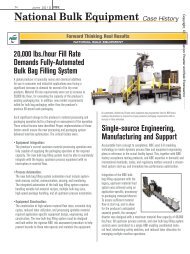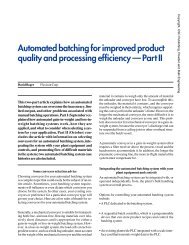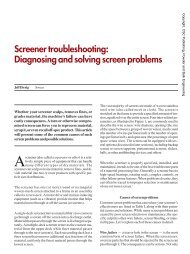A better storage tank system - Powder and Bulk Engineering Magazine
A better storage tank system - Powder and Bulk Engineering Magazine
A better storage tank system - Powder and Bulk Engineering Magazine
You also want an ePaper? Increase the reach of your titles
YUMPU automatically turns print PDFs into web optimized ePapers that Google loves.
A <strong>better</strong><br />
<strong>storage</strong> <strong>tank</strong><br />
<strong>system</strong><br />
An engineering company finds<br />
a way to improve its <strong>storage</strong><br />
<strong>tank</strong> installation process.<br />
Case history<br />
Stanco Projects, a division of<br />
SemcoSystemsLtd.,Richmond,<br />
British Columbia, designs, manufactures,<br />
<strong>and</strong> installs a wide range of<br />
turnkey bulk chemical h<strong>and</strong>ling <strong>system</strong>s<br />
for power, mining, <strong>and</strong> petrochemical<br />
facilities around the world.<br />
Thecompanyfrequentlyinstallschemical<br />
slurry makeup <strong>system</strong>s for produced<br />
water treatment at oil <strong>and</strong> gas<br />
facilities in northern Canada. Each <strong>system</strong><br />
includes of a large-diameter steel<br />
<strong>storage</strong> <strong>tank</strong> <strong>and</strong> various ancillary<br />
equipment. Since many of the oil <strong>and</strong><br />
gasfacilitiesarelocatedinremoteareas<br />
with limited access, shipping the <strong>tank</strong><br />
<strong>and</strong>otherequipmenttoafacility<strong>and</strong>assembling<br />
a <strong>system</strong> on-site is time-consuming<br />
<strong>and</strong> costly. Several years ago,<br />
the company needed to find a way to<br />
decrease the <strong>system</strong> installation time<br />
<strong>and</strong> costs, so it worked with a <strong>tank</strong> suppliertoimprovetheprocess.<br />
topped by a dust collector <strong>and</strong> a lower<br />
skirted section that holds ancillary<br />
equipment, including a slide gate,<br />
screw feeder, slurry mixer, slurry<br />
pump, <strong>and</strong> other controls <strong>and</strong> components.<br />
For many of the company’s<br />
projects, the <strong>tank</strong> can be up to 14 feet<br />
in diameter <strong>and</strong> up to 100 feet tall.<br />
In the past, the company typically purchased<br />
shop-welded steel <strong>tank</strong>s from<br />
one supplier <strong>and</strong> the other equipment<br />
fromother suppliers<strong>and</strong>shippedthese<br />
various <strong>system</strong> components to the installation<br />
site. An on-site assembly<br />
crew erected the <strong>tank</strong> by crane <strong>and</strong> installed<br />
the ancillary equipment inside<br />
the <strong>tank</strong>’s lower skirt section. However,<br />
this was an expensive <strong>and</strong> timeconsuming<br />
way to do things, says<br />
Dave Clarke, Stanco vice president of<br />
marketing, <strong>and</strong> it generally took about<br />
4 weeks to complete.<br />
Copyright, CSC Publishing, <strong>Powder</strong> <strong>and</strong> <strong>Bulk</strong> <strong>Engineering</strong><br />
System installation gets expensive<br />
A typical <strong>system</strong> consists of a <strong>storage</strong><br />
<strong>tank</strong> with an upper <strong>storage</strong> section<br />
“It’s expensive to transport equipment<br />
to remote locations,” says Clarke.<br />
“The farther away <strong>and</strong> more isolated a<br />
System components are installed inside a <strong>tank</strong> before the <strong>tank</strong> is transported<br />
to a job site.
job site is, the higher the freight costs.<br />
Also, the cost of getting a crew to <strong>and</strong><br />
from the site is expensive, <strong>and</strong> the<br />
working conditions can be difficult<br />
because of the weather. Then there’s<br />
the issue of overtime: A crew traveling<br />
fifteen hundred miles to a job site<br />
doesn’t want to work a st<strong>and</strong>ard fiveday,<br />
forty-hour week. They want to<br />
work straight through <strong>and</strong> get the job<br />
done as fast as possible so they can get<br />
back home to their families.”<br />
The company tried to reduce the cost<br />
of some projects by using local contractors<br />
to install the <strong>system</strong>s, but<br />
found that when it could find qualified<br />
contractors in such remote locations,<br />
they usually cost more. As the<br />
company began installing more <strong>system</strong>s<br />
at facilities in increasingly remote<br />
locations, it realized that to stay<br />
competitive it needed to decrease the<br />
number of workers required to install<br />
a <strong>system</strong> <strong>and</strong> the amount of time the<br />
workers spent at a job site.<br />
CST Industries Inc., Kansas City,<br />
Kans., manufactures <strong>storage</strong> <strong>tank</strong>s for<br />
companies in the minerals, plastics,<br />
chemicals, wood, grain, food, <strong>and</strong><br />
other dry bulk solids industries. In<br />
early 2000, with Stanco’s installation<br />
costs continuing to rise, the company<br />
decided to approach the <strong>tank</strong> supplier<br />
with an idea about improving the<br />
slurry <strong>system</strong> installation process.<br />
“We asked them if they could install<br />
the mechanical equipment inside a<br />
<strong>tank</strong> before shipping the <strong>tank</strong> to our<br />
installation site,” says Clarke. “They<br />
agreed to try this, <strong>and</strong> after discussions<br />
to determine the logistics, we<br />
had the equipment shipped to their<br />
welded steel <strong>tank</strong> production plant in<br />
Winchester, Tennessee, <strong>and</strong> they preassembled<br />
the first <strong>tank</strong> in about two<br />
weeks. This <strong>tank</strong> arrived at our job<br />
site with about seventy percent of the<br />
equipment already installed, which<br />
significantly reduced our installation<br />
costs <strong>and</strong> on-site time.”<br />
The company tried to reduce the<br />
cost of some projects by using local<br />
contractors to install the <strong>system</strong>s, but<br />
found that when it could find<br />
qualified contractors in such remote<br />
locations, they usually cost more.<br />
Copyright, CSC Publishing, <strong>Powder</strong> <strong>and</strong> <strong>Bulk</strong> <strong>Engineering</strong><br />
Long-time supplier provides<br />
solution<br />
Since 1975, one of the engineering<br />
company’s suppliers has been providing<br />
both bolted <strong>and</strong> welded steel <strong>tank</strong>s<br />
for the company’s various projects.<br />
Columbian TecTank, a division of<br />
The supplier continued to pre-assemble<br />
the <strong>system</strong>s for the engineering<br />
company, producing what it calls CIT<br />
<strong>system</strong>s, or component installed <strong>tank</strong><br />
<strong>system</strong>s. However, it soon became<br />
clear that “our projects were impacting<br />
their plant’s production efficiency,”<br />
says Clarke.<br />
A component installed <strong>tank</strong> <strong>system</strong> typically arrives at a job site with<br />
more than 70 percent of the required equipment already installed.
TheWinchesterplantwasdesignedfor<br />
manufacturing welded steel <strong>tank</strong>s as<br />
quickly <strong>and</strong> economically as possible,<br />
<strong>and</strong> pre-assembling the <strong>system</strong>s in the<br />
<strong>tank</strong>s interfered with that goal. So<br />
around 2006, the <strong>tank</strong> supplier built a<br />
second plant adjacent to the original<br />
Winchester plant that’s dedicated to<br />
making the CIT <strong>system</strong>s for the engineeringcompany<strong>and</strong>others.<br />
The component installed <strong>tank</strong><br />
<strong>system</strong>s<br />
The CIT <strong>system</strong>s use shop-welded<br />
carbon steel, stainless steel, or aluminum<br />
<strong>tank</strong>s that can vary in diameter<br />
<strong>and</strong> height, depending on a customer’s<br />
requirements. The <strong>system</strong>s can be<br />
used with such dry bulk solids as hydrated<br />
<strong>and</strong> quick lime, soda ash, magnesium<br />
oxide, activated carbon, alum,<br />
calcium sulphate, sodium sulphate,<br />
cement, fly ash, gold ores, polymers,<br />
<strong>and</strong> plastic pellets. Stanco primarily<br />
uses CIT <strong>system</strong>s with carbon steel<br />
<strong>tank</strong>s for hydrated lime, magnesium<br />
oxide, <strong>and</strong> soda ash slurry <strong>system</strong>s,<br />
which account for about 40 percent of<br />
its projects.<br />
The supplier installs various customer-supplied<br />
components in the<br />
<strong>tank</strong>, including electrical conduit,<br />
pumps <strong>and</strong> metering devices, bin activator<br />
<strong>and</strong> motor combinations, level<br />
indicators, vibratory units, volumetric<br />
feeders, piping <strong>and</strong> valves, <strong>and</strong> others.<br />
Components that are installed outside<br />
the <strong>tank</strong>, such as bin vent filters, ladders,<br />
guard rails, <strong>and</strong> level probes,<br />
can’t be attached to the <strong>tank</strong> during<br />
transport; however, the supplier runs<br />
the wires <strong>and</strong> conduit for those components<br />
so an installation crew can<br />
easily connect them on the job site.<br />
“We can build just about any size <strong>tank</strong><br />
<strong>and</strong> install the equipment required by<br />
the customer,” says David Wheat,<br />
Columbian TecTank director of dry<br />
bulk sales. “A company sends us the<br />
equipment <strong>and</strong> controls along with<br />
engineering drawings <strong>and</strong> local construction<br />
code information, <strong>and</strong> our<br />
technicians <strong>and</strong> licensed electricians<br />
install <strong>and</strong> wire everything accordingly.<br />
When everything is completed,<br />
Two cranes work in unison to install<br />
a <strong>tank</strong>, lifting <strong>and</strong> guiding the<br />
<strong>tank</strong> into place <strong>and</strong> st<strong>and</strong>ing it upright<br />
on a concrete base.<br />
we load the entire <strong>system</strong> onto a truck<br />
for transport. All the company has to<br />
do after the <strong>system</strong> gets to the job site<br />
is st<strong>and</strong> it up, reconnect the external<br />
accessories <strong>and</strong> utilities, plug it in,<br />
<strong>and</strong> it’s ready to go.”<br />
CIT <strong>system</strong>s improve installation<br />
process<br />
The CIT <strong>system</strong>s have improved the<br />
engineering company’s installation<br />
efficiency <strong>and</strong> decreased <strong>system</strong> installation<br />
costs <strong>and</strong> travel <strong>and</strong> overtime<br />
expenses. “Since the CIT<br />
<strong>system</strong>s eliminate a lot of on-site<br />
work, it only takes us up to about one<br />
<strong>and</strong> a half weeks to install one, which<br />
is less than half the time of assembling<br />
everything at the job site,” says<br />
Clarke. “This allows us to meet tight<br />
installation deadlines, <strong>and</strong> it also cuts<br />
the installation costs by about seventy-five<br />
percent, since we require<br />
fewer workers at the job site for less<br />
time. Overall, we’ve found the CIT<br />
<strong>system</strong>s to be a cost-effective <strong>and</strong><br />
time-saving solution.”<br />
The CIT <strong>system</strong>s have also improved<br />
the quality of the <strong>system</strong>s that the<br />
company installs. “The equipment<br />
<strong>and</strong> controls are installed in the controlled<br />
environment of the supplier’s<br />
After the <strong>tank</strong> is secured to its<br />
base, the <strong>system</strong>’s bin vent filter,<br />
level probes, <strong>and</strong> other exterior<br />
components are installed on the<br />
<strong>tank</strong>.<br />
plant rather than outside in the middle<br />
of subzero weather, so the assembly is<br />
done <strong>better</strong>,” says Clarke. “And before<br />
we transport a CIT <strong>system</strong> to a<br />
job site, we thoroughly inspect it, <strong>and</strong><br />
usually have our client inspect it as<br />
well, so they know exactly what<br />
they’re getting before it arrives at their<br />
facility. If any problems or deficiencies<br />
are found, we correct them before<br />
transporting the <strong>tank</strong>. This reduces<br />
the installation <strong>and</strong> start-up time <strong>and</strong><br />
ensures a quality installation.” PBE<br />
Note: Find more information on this<br />
topic in articles listed under “System<br />
or equipment design” <strong>and</strong> “Storage”<br />
in <strong>Powder</strong> <strong>and</strong> <strong>Bulk</strong> <strong>Engineering</strong>’s<br />
comprehensive Article Index in the<br />
December 2008 issue <strong>and</strong> at PBE’s<br />
Web site, www.powderbulk.com. You<br />
can also purchase copies of past PBE<br />
articles at www.powderbulk.com.<br />
Columbian TecTank,<br />
Kansas City, KS<br />
913-621-3700<br />
www.columbiantec<strong>tank</strong>.com<br />
Copyright, CSC Publishing, <strong>Powder</strong> <strong>and</strong> <strong>Bulk</strong> <strong>Engineering</strong>


